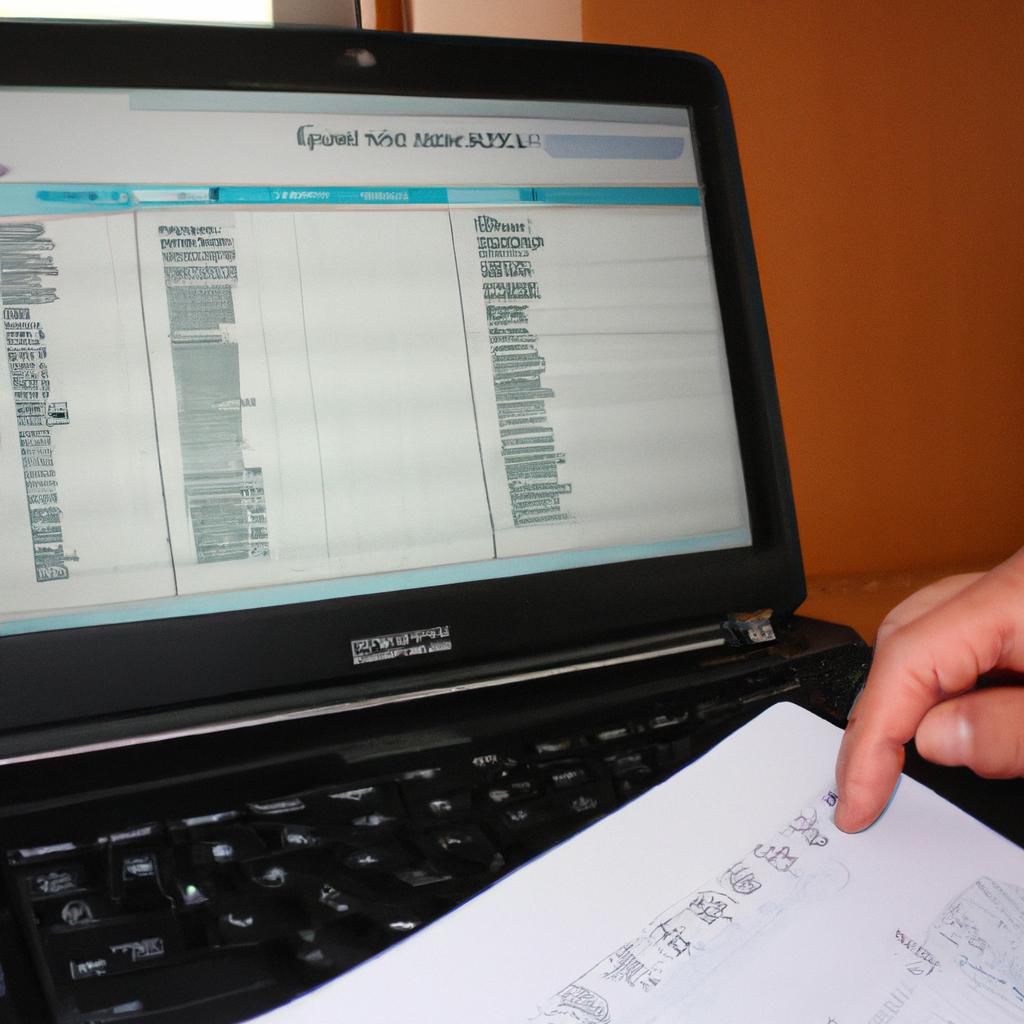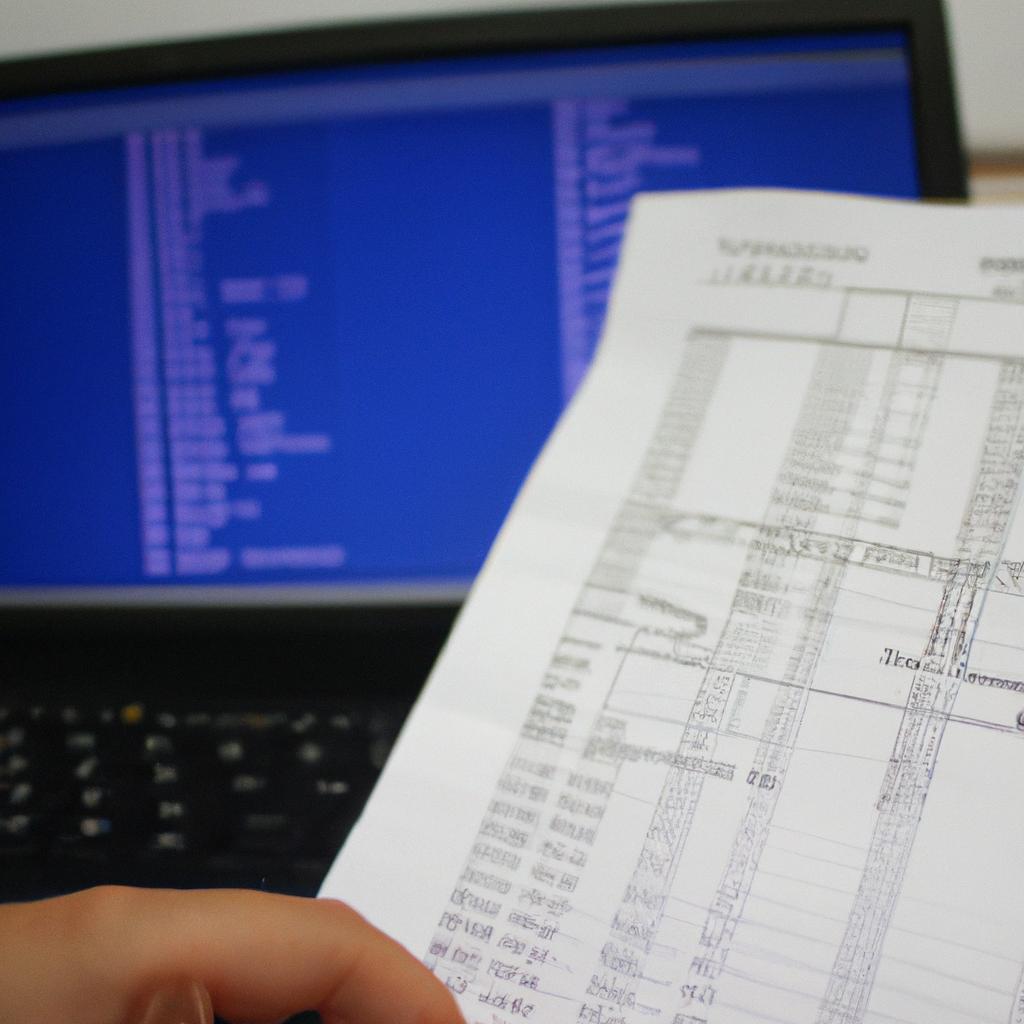Timekeeping in Accounting Software: Streamlining Payroll Management

Timekeeping plays a crucial role in payroll management, as it serves as the foundation for accurate and efficient processing of employee wages. In today’s fast-paced business environment, where time is a valuable commodity, organizations are increasingly turning to accounting software solutions to streamline their payroll processes. These software programs offer advanced features that not only track employees’ work hours but also automate calculations and generate detailed reports. This article explores the significance of timekeeping in accounting software and how it can revolutionize payroll management.
Consider the scenario of a mid-sized manufacturing company with hundreds of employees working across various departments. Traditionally, this company relied on manual timekeeping methods such as punch cards and timesheets, resulting in frequent errors, inefficiencies, and delays in payroll processing. However, after implementing an accounting software solution with robust timekeeping capabilities, the company experienced a significant transformation. By enabling employees to clock in and out electronically using biometric devices or mobile applications, the software eliminated instances of buddy punching while providing real-time visibility into attendance data. Moreover, by integrating seamlessly with other modules like leave management and overtime calculation, the system automated complex tasks associated with payroll processing. As a result, the organization witnessed improved accuracy, reduced administrative burden, and enhanced overall efficiency in managing its workforce’s time and attendance.
The accounting software’s timekeeping functionality allowed the company to accurately track employees’ work hours, breaks, and overtime, eliminating any discrepancies or disputes. This ensured that employees were paid correctly for the time they worked, while also complying with labor laws and regulations.
Furthermore, the system generated detailed reports that provided insights into employee productivity, absenteeism rates, and labor costs. These reports helped management make informed decisions regarding workforce planning, scheduling, and budgeting.
In addition to streamlining payroll processes, the accounting software’s timekeeping capabilities also benefited employees. With user-friendly interfaces and self-service options, employees could easily access their attendance records, submit leave requests, and view their upcoming schedules. This improved transparency and empowered employees to take ownership of their time management.
Overall, implementing accounting software with robust timekeeping capabilities revolutionized payroll management for the manufacturing company. It eliminated manual errors, reduced administrative tasks associated with payroll processing, improved accuracy in wage calculations, and provided valuable insights into workforce productivity. By leveraging technology to automate timekeeping processes, organizations can save time and resources while ensuring fair compensation for their employees.
Timekeeping features in accounting software
Timekeeping is a critical aspect of payroll management in any organization. With the advent of accounting software, businesses can now streamline their timekeeping processes efficiently and effectively. This section explores the various features offered by accounting software that enhance timekeeping practices.
One example of such software is QuickBooks, which offers robust timekeeping features designed to simplify the recording and tracking of employee hours. By integrating with other modules within the software, such as invoicing or project management, it allows for seamless transfer of data across different functions. For instance, an employee’s recorded hours can be directly linked to their respective projects or clients, making it easier to generate accurate invoices based on billable hours.
- Increased accuracy: Manual timekeeping methods are prone to errors and discrepancies. Accounting software automates this process, minimizing human error and ensuring precise calculations.
- Improved efficiency: Time spent on manual data entry and reconciliation is significantly reduced when utilizing automated timekeeping features. This enables employees to focus on more value-added tasks.
- Enhanced compliance: Compliance with labor laws and regulations becomes simpler through automatic calculation of overtime pay rates and adherence to legal requirements regarding breaks and working hours.
- Streamlined reporting: Accounting software provides comprehensive reports summarizing employee attendance records, enabling managers to gain insights into workforce productivity trends.
In addition to these features, accounting software often includes a variety of customizable settings that allow organizations to tailor their timekeeping processes according to specific needs. These may include options for configuring work schedules, defining leave policies, or setting up approval workflows.
Transitioning into the subsequent section about “Benefits of using timekeeping in payroll management,” it becomes evident that incorporating timekeeping functions within accounting software not only simplifies administrative tasks but also yields several advantages for employers and employees alike.
Benefits of using timekeeping in payroll management
Timekeeping in accounting software offers numerous benefits for streamlining payroll management. By utilizing these features, businesses can effectively track employee work hours and automate the process of calculating wages, resulting in improved accuracy, efficiency, and cost-effectiveness.
For instance, let’s consider a hypothetical case study where Company X implemented timekeeping features in their accounting software. Previously, they relied on manual timesheets and spreadsheets to record employees’ working hours. This method was not only time-consuming but also prone to errors and discrepancies. However, after integrating timekeeping into their accounting software, Company X experienced several advantages.
Firstly, the use of electronic time clocks or mobile applications enabled employees to easily clock in and out using their unique credentials. This eliminates the need for paper-based systems while ensuring accurate recording of work hours. Additionally, the automation of time calculations reduces human error and prevents instances of fraudulent practices such as buddy punching.
Furthermore, incorporating timekeeping within accounting software allows for seamless integration with other payroll processes. Payroll administrators can effortlessly import recorded data directly into wage calculation modules, eliminating the need for manual data entry and reducing the risk of transcription mistakes. This integration also facilitates real-time tracking of labor costs and aids in generating comprehensive reports for analysis and decision-making purposes.
- Increased productivity: Streamlined payroll management frees up valuable time that can be allocated towards more productive tasks.
- Enhanced accuracy: Automation minimizes human errors associated with manual calculations and transcriptions.
- Cost savings: Eliminating paper-based systems reduces administrative costs related to printing supplies and storage spaces.
- Improved compliance: Timekeeping features ensure adherence to labor laws by accurately monitoring overtime hours and breaks.
Additionally, we present a table comparing traditional manual methods versus automated timekeeping features:
| Traditional Manual Methods | Automated Timekeeping Features |
|---|---|
| Paper-based timesheets | Electronic time clocks or mobile applications |
| Manual data entry | Seamless integration with payroll systems |
| Increased chance of errors | Improved accuracy and compliance |
| Time-consuming processes | Streamlined operations and cost savings |
In conclusion, the implementation of timekeeping features in accounting software significantly enhances payroll management by automating employee work hour tracking, improving accuracy, and increasing efficiency. The benefits include increased productivity, enhanced accuracy, cost savings, and improved compliance. Integrating timekeeping within accounting software enables businesses to streamline their payroll processes effectively.
To ensure a seamless transition into the subsequent section about “Integrating timekeeping with accounting software,” it is vital for organizations to consider how these features can be incorporated seamlessly without disrupting existing workflows.
Integrating timekeeping with accounting software
Having discussed the benefits of incorporating timekeeping into payroll management, let us now explore how integrating timekeeping with accounting software can further streamline this crucial aspect of business operations. To illustrate its effectiveness, consider the case study below.
Example Case Study:
ABC Company is a medium-sized manufacturing firm that recently implemented an integrated timekeeping and accounting software solution. Prior to this implementation, ABC Company relied on manual timesheets and separate accounting systems for processing employee hours and payroll calculations. This process was not only labor-intensive but also prone to errors, leading to delayed payments and dissatisfied employees.
Paragraph 1:
Integrating timekeeping with accounting software offers several advantages for businesses aiming to optimize their payroll management processes. Firstly, it allows for real-time tracking of employee attendance, enabling supervisors to monitor workforce productivity more efficiently. By automating the collection of accurate data directly from digital clock-in systems or biometric devices, potential discrepancies related to inaccurate reporting or buddy punching are significantly reduced.
- Improved accuracy in calculating overtime pay
- Enhanced compliance with labor laws regarding minimum wage and work hour regulations
- Increased transparency and accountability within the organization
- Reduced administrative burden through automated calculation processes
Paragraph 2:
To emphasize the impact of integrating timekeeping with accounting software visually, let us examine the following table showcasing key statistics before and after implementing such a system at ABC Company:
| Metrics | Before Implementation | After Implementation |
|---|---|---|
| Average Payroll Processing Time (hours) | 12 | 4 |
| Payroll Errors | Frequent | Rare |
| Employee Satisfaction | Low | High |
The stark contrast between these metrics demonstrates how the integration of timekeeping with accounting software can streamline payroll management, resulting in substantial improvements across various aspects of business operations.
Paragraph 3:
By integrating timekeeping with accounting software, organizations can significantly reduce manual effort and eliminate errors associated with traditional payroll processing methods. This streamlined approach not only ensures timely and accurate payments to employees but also enhances overall workforce productivity and satisfaction. In the subsequent section, we will delve into how this integration facilitates efficient payroll calculations through automated processes, further optimizing payroll management.
With a comprehensive understanding of the benefits brought about by integrating timekeeping with accounting software, let us now explore how this synergy streamlines the complex task of calculating payrolls without compromising accuracy or efficiency.
Streamlining payroll calculations with timekeeping
By integrating timekeeping with accounting software, businesses can effectively streamline their payroll management processes. Now, let’s explore how this integration further enhances the efficiency and accuracy of payroll calculations.
Streamlining Payroll Calculations with Timekeeping
To illustrate the benefits of using integrated timekeeping systems, consider a hypothetical case study of Company XYZ, a mid-sized manufacturing firm. Prior to implementing an integrated system, the company relied on manual timesheets and Excel spreadsheets for recording employee hours and calculating wages. However, this process was prone to errors and often resulted in discrepancies between reported hours and actual work performed.
-
Increased Accuracy:
With an integrated timekeeping solution, such as QuickBooks or ADP Workforce Now, employees can clock in and out through designated platforms that automatically sync data directly into the accounting software. This eliminates human error associated with manual data entry and reduces the risk of inaccuracies during payroll processing. -
Enhanced Efficiency:
Automated time tracking significantly reduces administrative burden by eliminating the need for tedious data input tasks. Instead of spending valuable hours manually collecting timesheets from multiple sources and transferring information into spreadsheets, HR personnel can focus on more strategic activities within the organization. -
Seamless Data Integration:
An integrated system ensures seamless flow of information by synchronizing all relevant data across different modules within the accounting software. This allows for real-time updates on employee attendance, overtime hours, vacation days taken, etc., which are essential components for accurate payroll calculations. -
Improved Compliance:
Integrated timekeeping systems facilitate compliance with labor laws and regulations by accurately tracking statutory requirements such as minimum wage rates, overtime thresholds, and leave entitlements. By automating these processes based on predefined rules within the software, organizations can ensure adherence to legal obligations and minimize the risk of non-compliance penalties.
Table: Benefits of Integrated Timekeeping Systems
| Benefit | Explanation |
|---|---|
| Increased Accuracy | Automated data syncing eliminates human errors, reducing discrepancies between reported hours and actual work performed. |
| Enhanced Efficiency | Administrative burden is reduced as time-consuming manual tasks are replaced with automated processes. |
| Seamless Data Integration | Real-time updates on attendance, overtime, and leave balances allow for accurate payroll calculations. |
| Improved Compliance | The system tracks statutory requirements, ensuring compliance with labor laws and minimizing the risk of penalties. |
By incorporating integrated timekeeping systems into their accounting software, businesses like Company XYZ can experience enhanced accuracy in payroll calculations while also benefiting from improved efficiency and compliance. This integration not only streamlines the overall payroll management process but also allows HR departments to allocate their time more strategically within the organization.
With streamlined payroll calculations through integrated timekeeping solutions, it becomes crucial for organizations to focus on ensuring accuracy and efficiency in all aspects of payroll processing.
Ensuring accuracy and efficiency in payroll processing
To illustrate these concepts, consider a hypothetical case study involving a medium-sized company that recently implemented an advanced accounting software system equipped with robust timekeeping features.
Case Study: The XYZ Company is a growing organization with over 200 employees spread across multiple locations. Prior to adopting the new accounting software, they relied on manual methods for tracking employee work hours, resulting in frequent errors and delays during payroll processing. However, since integrating their timekeeping process with the accounting software, significant improvements have been observed. Not only has it streamlined their payroll management by automating key tasks, but it has also enhanced accuracy and efficiency throughout the entire process.
To highlight the benefits of incorporating timekeeping within accounting software systems for streamlined payroll management, let us explore four key advantages:
-
Enhanced Accuracy: By eliminating manual entry errors and reducing reliance on paper-based timesheets, automated timekeeping ensures precise recording of employee work hours. This leads to more accurate calculation of wages without discrepancies or miscalculations caused by human error.
-
Time Savings: With traditional methods, HR personnel spent countless hours manually inputting data from various sources into separate spreadsheets or payroll systems. In contrast, integrated timekeeping in accounting software significantly reduces administrative burden by automatically transferring relevant information directly to payroll modules.
-
Increased Efficiency: Automated workflows enable swift and efficient review and approval processes for timesheets before finalizing payrolls. Supervisors can easily verify attendance records, leave requests, overtime approvals – all at their fingertips – ensuring smooth operations and minimizing bottlenecks.
-
Compliance & Reporting: Timekeeping features built into modern accounting software allow businesses to effortlessly generate comprehensive reports required for compliance purposes such as labor regulations or auditing requirements. These customizable reports provide detailed insights into workforce productivity trends while aiding in decision-making processes.
| Advantages of Timekeeping Integration |
|---|
| Enhanced Accuracy |
| Eliminates manual entry errors. |
| Precise recording of work hours. |
| Ensures compliance with labor regulations. |
In conclusion, the integration of timekeeping within accounting software revolutionizes payroll management by streamlining calculations and ensuring accuracy and efficiency throughout the process. By eliminating manual errors, reducing administrative tasks, expediting workflows, and providing robust reporting capabilities, businesses can optimize their payroll operations while complying with regulatory standards.
Moving forward, let us explore best practices for implementing timekeeping features in accounting software to maximize its potential benefits.
Best practices for timekeeping in accounting software
In order to ensure accuracy and efficiency in payroll processing, businesses can leverage the power of timekeeping features available in accounting software. By integrating timekeeping functionality into their financial management systems, organizations can streamline their payroll processes and avoid potential errors or discrepancies.
For example, consider a small retail business that employs hourly workers. Without an automated timekeeping system, the business relies on manual timesheets submitted by employees at the end of each pay period. This process is not only time-consuming but also prone to human error. However, by implementing an accounting software with built-in time tracking capabilities, the business can eliminate these challenges and improve its overall payroll management.
To further highlight the benefits of using timekeeping features within accounting software, let’s explore some key advantages:
- Increased Accuracy: Automated timekeeping reduces the risk of transcription errors that often occur when manually inputting hours worked. With accurate data directly imported from digital clocks or online timesheets, businesses can confidently calculate employee wages without worrying about calculation mistakes.
- Efficient Payroll Processing: The integration between timekeeping and accounting software allows for seamless transfer of data from one system to another. This integration eliminates the need for manual data entry and significantly speeds up the payroll processing timeline.
- Improved Compliance: By utilizing time tracking features within accounting software, businesses can easily monitor employee work hours for legal compliance purposes such as overtime calculations or labor law requirements.
- Enhanced Employee Experience: Implementing user-friendly timekeeping tools empowers employees to conveniently record their work hours, view schedules, and access relevant information related to their compensation. This streamlined approach creates a positive experience for staff members while reducing administrative burdens on HR personnel.
To better visualize how incorporating timekeeping in accounting software enhances payroll management effectiveness, refer to the following table:
| Benefits | Description |
|---|---|
| Increased Accuracy | Automated timekeeping reduces the risk of transcription errors. |
| Efficient Payroll Processing | Seamlessly transfer data between systems and eliminate manual data entry. |
| Improved Compliance | Monitor employee work hours for legal compliance purposes. |
| Enhanced Employee Experience | Empower employees to conveniently record their work hours and access information. |
In conclusion, integrating timekeeping features into accounting software offers significant advantages in streamlining payroll management processes. Businesses can achieve increased accuracy, efficient processing, improved compliance, and an enhanced employee experience by leveraging this technology. By embracing these best practices, organizations can ensure a smooth and error-free payroll process while optimizing productivity across their workforce.




